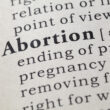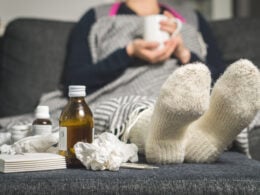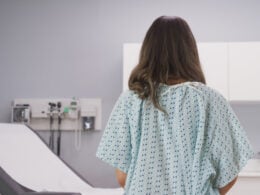“Debbie, are you ever depressed?” The questions startled Debra Brock, a 44-year-old registered nurse from Virginia. Yes, she was. She had been for several years. More surprising even was who was asking. It wasn’t a therapist, nor a psychiatrist. It was a nurse who was looking at Debra’s blood tests results[i]. “Your hormone levels are so very low,” the nurse told Debra.
PMS or pre-menstrual syndrome happens to 13 to 18% to women in the United States[ii]. Most of us know someone who suffers from it. Maybe it’s you. At least 2% of women―according to the American Psychological Association, 3 to 9% of women―suffer from a more serious form of PMS called PMDD, or pre-menstrual dysphoric dysfunction, which is so debilitating that women can’t function. “PMDD is like supercharged PMS[iii].”
Oral contraceptives are widely prescribed by doctors as a solution to PMS[iv]. “The Pill can provide relief by steadying hormones, but different symptoms require different pills,” says an article on WebMD. While the FDA approved Bayer’s combination birth control pill Yaz as a treatment for PMDD, Bayer ended up in a major lawsuit for false advertising that cost the company $1.4 billion, mainly because of the severe risks and side-effect caused by this drug[v].
Taking the Pill to stop PMS is a little bit like taking steroids every day for years for a common cold.
You certainly change some of the symptoms, because you hijack your body’s normal functioning with a chemical that acts on your brain and changes your hormonal balance. But hormonal contraceptives don’t always help with the emotional symptoms: the depression, the anxiety and mood swings. Sometimes it makes them worse.
Anti-depressants are the next line of combat. They do work and are sometimes necessary to help someone experiencing the severe effects of depression. I have worked in the psychiatric field for the past five years and I see that anti-depressants can be necessary and even life-saving in some cases. I also know that they come with a number of side-effects and risk being prescribed too casually. Of US women age 40 to 59, 22% are taking an anti-depressant and 9.2% of women ages 18-39[vi]. The New York Times called it “A glut of anti-depressants[vii].”
What if there were a way to treat PMS without the use of powerful chemicals like the Pill or anti-depressants?
There is.
The first step is to acknowledge that PMS is a real illness with a real physical cause. Women are afraid of talking about PMS. They don’t think they will be taken seriously, or they’re afraid they will be put on a psychiatric drug. “I didn’t understand what was happening; I was afraid to tell my friends and family, which only worsened my anxiety. I was also afraid to discuss these symptoms with my OB/GYN, because I was afraid he would prescribe an anti-depressant, and I didn’t want to go on medication,” reported a patient to a doctor at the NYU Langone Medical Center[viii]. A study showed that 45% of women had never discussed PMS with their doctors and 24% of respondents who described their symptoms as strong or severe felt their doctors would not take their complaints seriously[ix].
PMS symptoms can be physical and/or emotional.
To qualify for PMS, symptoms occur at least 5 days before periods start[x].
- Physical signs: bloating, breast tenderness, headaches/backaches, food cravings/overeating, fatigue, weight gain
- Mental and emotional signs: mood swings and/or depression, trouble concentrating, anxiety, anger, tearfulness
PMDD symptoms are more severe and always include the mental and emotional signs.
Many sources, including ACOG[xi], the Mayo Clinic[xii] and WebMD, recommend changes in diet and life style. They also suggest herbal medicine and supplements. While these can definitely help and are good suggestions in general, the recommendations almost contribute to the stigma. It makes women responsible for something that they can’t control: “If you ate better and exercised you would feel better.” This misconception can even lead to more anxiety and stress.
There is a medical solution few talk about.
It’s a solution that respects the ovulation process of women, and that doesn’t target the brain chemistry. And it works.
To understand how a non-contraceptive solution can cure PMS, you have to understand the root cause. Put simply, PMS is often the result of a deficit in progesterone, a hormone that the woman’s body produces at certain times of her cycle[xiii]. The production of these hormones increases right after ovulation. Or so it should. It’s when it doesn’t that symptoms of PMS appear. In the case of Debra, she had only one-third of the normal estrogen and progesterone levels for a woman her age. “Can it be cured?” she asked the nurse on the phone. A simple solution is to increase the level of this hormones at the right time, which is right after ovulation.
And that’s where the cookie crumbles. For several reasons. First, if you’re on hormonal contraceptives, you don’t ovulate, so you can’t know what’s really going on in your body hormonally. If you’re not on hormonal contraceptives, you need to know when you ovulate, which means that you need to chart. Most doctors don’t know or believe that women can chart. In fact, several medical studies designed to test if progesterone supplements would relieve PMS didn’t take into consideration the critical fact that most women don’t ovulate exactly in the middle of their cycle. If you take a progesterone supplement before ovulation, it doesn’t work. You have to know when you ovulate. These faulty studies showed that progesterone treatment didn’t work, and therefore missed identifying the best solution for this problem.
Dr. Thomas Hilgers, OB/Gyn, is a pioneer in Fertility Awareness and the founder of the Natural Procreation Technology (NaPro TECHNOLOGY™). His research is revolutionary because he is using individual patients’ cycle patterns to understand, diagnose and treat the disorders that may affect them. And it works. He has documented results in the past thirty years with work done on thousands of women. His treatment of PMS and PMDD lead to a marked or moderate improvement of 95.2% of patients, compared to 43% of patients who take the anti-depressant fluoxetine (Prozac®).
So how do you treat PMS without the Pill?
Here is what Debra did:
- Charted her cycles, which means she was not on hormonal contraceptives (when you learn to chart, you discover that it is a very effective way of avoiding pregnancy and to learn about your body),
- Got a blood test to measure her hormonal levels,
- Took hCG or bio-identical hormones that stimulate the ovaries to produce progesterone and estrogen. They have to be taken between the time of ovulation and her period or it will not be effective.
Obviously this is not something you do on your own. You need the following help:
- Learning to chart, which can be done from a book, online or in a class, so you know exactly where you are in your cycle and when you ovulate,
- Identifying the problem and treating it with the proper hormones at the right time can be done with the help of an OB/Gyn who has been trained in NaProTECHNOLOGY. They are all over the US and their network is growing worldwide.
While it may sound complicated, it’s worth the effort, because you are treating the root cause of PMS and avoiding the serious health risks of hormonal contraceptives or anti-depressants. “Generally, patients stay on the treatment for a year and after that time, consideration can be given to discontinuing the treatment,” writes Dr. Hilgers.
Here is what Debra wrote about her experience: “My depression disappeared immediately and has not returned. I can laugh again. My husband said he saw a mask lifted from my face. I love this life!”
Worth consideration.
References
[i] This testimony and other reference to NaProTechnology are quoted from the book The NaProTECHNOLOGY Revolution, Unleashing the Power in a Woman’s Cycle, by Thomas W. Hilgers, MD, Beaufort Books, New York, 2010
[ii] http://www.uptodate.com/contents/epidemiology-and-pathogenesis-of-premenstrual-syndrome-and-premenstrual-dysphoric-disorder
[iii] http://www.apa.org/monitor/oct02/pmdd.aspx
[iv] http://www.webmd.com/women/pms/premenstrual-syndrome-pms-medications
[v] http://topclassactions.com/lawsuit-settlements/prescription/5008-bayer-pays-out-1-4-billion-in-yaz-lawsuit-settlements/
[vi] http://www.cdc.gov/nchs/data/databriefs/db76.htm
[vii] http://well.blogs.nytimes.com/2013/08/12/a-glut-of-antidepressants/?_r=0
[viii] http://medicine.med.nyu.edu/conditions-we-treat/conditions/in-her-own-words-living-with-premenstrual-syndrome-pms[ix] file:///C:/Users/Gerard/Downloads/OBGYN.Net_-_PMDD_or_PMS_Is_there_a_difference_-_2014-01-17%20(1).pdf See also: http://www.ncbi.nlm.nih.gov/pubmed/21775045
[x] http://www.apa.org/monitor/oct02/pmdd.aspx and
http://www.webmd.com/women/guide/premenstrual-syndrome
[xi] https://www.acog.org/-/media/For-Patients/faq057.pdf?dmc=1&ts=20141122T0602130409
[xii] http://www.mayoclinic.org/diseases-conditions/premenstrual-syndrome/basics/treatment/con-20020003
[xiii] For more information see The NaProTECHNOLOGY Revolution, Unleashing the Power in a Woman’s Cycle, by Thomas W. Hilgers, MD, Beaufort Books, New York, 2010











